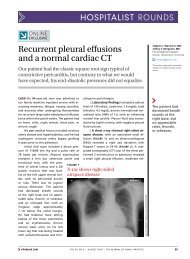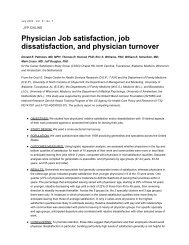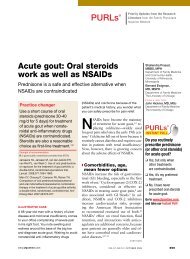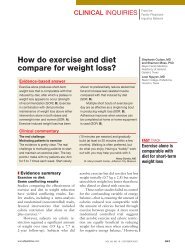Clinical Inquiries - The Journal of Family Practice
Clinical Inquiries - The Journal of Family Practice
Clinical Inquiries - The Journal of Family Practice
Create successful ePaper yourself
Turn your PDF publications into a flip-book with our unique Google optimized e-Paper software.
• universal screening at 12 and 24 months <strong>of</strong> age:<br />
• in communities where the prevalence <strong>of</strong><br />
blood lead levels ≥10 µg/dL exceeds 12% <strong>of</strong><br />
children<br />
• in communities where ≥27% <strong>of</strong> housing was<br />
built before 1950<br />
• for all children enrolled in Medicaid.<br />
Otherwise screening should be targeted based<br />
on a questionnaire on age <strong>of</strong> housing, recent or<br />
ongoing remodeling, and having a sibling or playmate<br />
diagnosed with lead poisoning, in addition to<br />
questions on locally important risk factors. 9<br />
<strong>The</strong> American Academy <strong>of</strong> Pediatrics endorses<br />
the CDC recommendations. 2 <strong>The</strong> US Preventive<br />
Services Task Force, the American Academy <strong>of</strong><br />
<strong>Family</strong> Physicians, and the American College <strong>of</strong><br />
Preventive Medicine all recommend screening for<br />
lead poisoning at 12 months <strong>of</strong> age in children<br />
with demographic or geographic risk factors. 3,10,11<br />
Amy C. Denham, MD, MPH, Department <strong>of</strong> <strong>Family</strong><br />
Medicine, University <strong>of</strong> North Carolina at Chapel Hill; Linda<br />
J. Collins, MSLS, Health Sciences Library, University <strong>of</strong><br />
North Carolina at Chapel Hill<br />
■ CLINICAL COMMENTARY<br />
Lead screening: Think locally<br />
<strong>The</strong> local health department can provide information<br />
about lead screening in your community,<br />
whether based on blood levels or the housing<br />
conditions. If your patients need screening,<br />
you may want to add a reminder on a flow<br />
sheet in the chart to do a questionnaire or a<br />
blood draw. Finding and treating severely elevated<br />
lead levels can change outcomes, but for<br />
less elevated levels, the evidence shows no<br />
benefit. You should work with the health<br />
department when considering therapy for children<br />
with elevated blood lead levels.<br />
Julia Fashner, MD, St. Joseph Regional Medical<br />
Center, South Bend, Ind<br />
REFERENCES<br />
1. Kaufmann RB, Clouse TL, Olson DR, Matte TD. Elevated<br />
blood lead levels and blood lead screening among US children<br />
aged one to five years: 1988–1994. Pediatrics 2000;<br />
106:E79.<br />
724 SEPTEMBER 2003 / VOL 52, NO 9 · <strong>The</strong> <strong>Journal</strong> <strong>of</strong> <strong>Family</strong> <strong>Practice</strong><br />
CLINICAL INQUIRIES<br />
2. Screening for elevated blood lead levels. American<br />
Academy <strong>of</strong> Pediatrics Committee on Environmental<br />
Health. Pediatrics 1998; 101:1072–1078.<br />
3. US Preventive Services Task Force. Guide to <strong>Clinical</strong><br />
Preventive Services. 2nd ed. Baltimore, Md: Lippincott<br />
Williams & Wilkins; 1996.<br />
4. Binns HJ, LeBailly SA, Fingar AR, Saunders S. Evaluation<br />
<strong>of</strong> risk assessment questions used to target blood lead<br />
screening in Illinois. Pediatrics 1999; 103:100–106.<br />
5. Rogan WJ, Dietrich KN, Ware JH, et al. <strong>The</strong> effect <strong>of</strong> chelation<br />
therapy with succimer on neuropsychological development<br />
in children exposed to lead. N Engl J Med 2001;<br />
344:1421–1426.<br />
6. Haynes E, Lanphear BP, Tohn E, Farr N, Rhoads GG. <strong>The</strong><br />
effect <strong>of</strong> interior lead hazard controls on children’s blood<br />
lead concentrations: a systematic evaluation. Environ<br />
Health Perspect 2002; 110:103–107.<br />
7. Hilts SR, Hertzman C, Marion SA. A controlled trial <strong>of</strong> the<br />
effect <strong>of</strong> HEPA vacuuming on childhood lead exposure.<br />
Can J Public Health 1995; 86:345–350.<br />
8. Ballew C, Bowman B. Recommending calcium to reduce<br />
lead toxicity in children: a critical review. Nutr Rev 2001;<br />
59(3 Pt 1):71–79.<br />
9. Centers for Disease Control and Prevention. Screening<br />
Young Children for Lead Poisoning: Guidance for State and<br />
Local Public Health Officials. Atlanta, Ga: CDC, 1997.<br />
10. AAFP Policy Recommendations for Periodic Health<br />
Examinations. 2002. Available at http://www.aafp.org/<br />
exam.xml. Accessed on February 9, 2003.<br />
11. Lane WG, Kemper AR. American College <strong>of</strong> Preventive<br />
Medicine <strong>Practice</strong> Policy Statement. Screening for elevated<br />
blood lead levels in children. Am J Prev Med 2001;<br />
20:78–82.<br />
Watch for these topics<br />
appearing soon in<br />
THE JOURNAL OF<br />
FAMILY<br />
PRACTICE<br />
• Idiopathic venous thromboembolism:<br />
Evaluation that makes sense<br />
• How should we manage an acute<br />
exacerbation <strong>of</strong> COPD?<br />
• How practice-based research changed<br />
the way I manage depression








